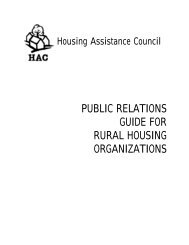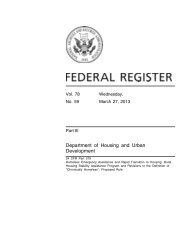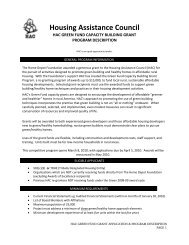Picking Up the Pieces - Housing Assistance Council
Picking Up the Pieces - Housing Assistance Council
Picking Up the Pieces - Housing Assistance Council
You also want an ePaper? Increase the reach of your titles
YUMPU automatically turns print PDFs into web optimized ePapers that Google loves.
INTRODUCTION<br />
Disaster relief efforts in <strong>the</strong> United States are coordinated by <strong>the</strong> Federal Emergency Management<br />
Agency (FEMA), now part of <strong>the</strong> Department of Homeland Security. Not every disaster warrants<br />
FEMA’s intervention, but under <strong>the</strong> provisions of <strong>the</strong> legislation that established FEMA, when a<br />
disaster “is beyond <strong>the</strong> capabilities of state and local resources,” <strong>the</strong> President may declare a “major<br />
disaster” or an “emergency.” Local, state, and FEMA officials evaluate <strong>the</strong> disaster, and submit a<br />
request for a declaration to <strong>the</strong> Director of FEMA, who reviews <strong>the</strong> request, submits it to <strong>the</strong><br />
President, and makes recommendations to <strong>the</strong> President.<br />
When <strong>the</strong> President makes a major disaster declaration, FEMA establishes offices in <strong>the</strong> federally<br />
declared disaster area to serve as centralized points of relief management. FEMA aids disaster<br />
survivors by directing <strong>the</strong>m to <strong>the</strong> assistance program(s) (both public and private) for which <strong>the</strong>y<br />
are eligible and that will be of <strong>the</strong> most benefit to <strong>the</strong>m. In sum, <strong>the</strong> agency serves as <strong>the</strong> umbrella<br />
organization that coordinates <strong>the</strong> relief efforts of all relief agencies, public and private, local and<br />
national. Thus it brings disaster recovery assistance into <strong>the</strong> stricken community.<br />
FEMA’s role is especially important to disaster victims in rural areas due to a scarcity of local<br />
institutions with ready access to potential recovery resources and <strong>the</strong> ability to coordinate relief<br />
efforts. However, in spite of FEMA’s coordination, one of <strong>the</strong> most serious problems facing disaster<br />
victims in rural areas may still be a lack of information about <strong>the</strong> resources and assistance available<br />
to <strong>the</strong>m. The <strong>Housing</strong> <strong>Assistance</strong> <strong>Council</strong> (HAC) has prepared this guide to short- and long-term<br />
housing and community development resources as a partial response to that critical need. It is<br />
intended for use by disaster-affected individual households as well as by community organizations<br />
acting on <strong>the</strong>ir behalf.<br />
It is hoped that this guide will inform local efforts to match resources with need more efficiently.<br />
Moreover, it is hoped that <strong>the</strong> guide’s identification of existing contact persons and agencies will<br />
increase coordination among <strong>the</strong>m and stimulate <strong>the</strong> fur<strong>the</strong>r development of community-based<br />
resources such as housing development corporations and advocacy agencies.<br />
Following this Introduction, a section entitled “Initial Response” outlines <strong>the</strong> process that<br />
disaster-stricken communities can expect to undergo following <strong>the</strong> catastrophe. The section on<br />
“Specific <strong>Housing</strong> Resources for Disasters” describes <strong>the</strong> principal forms of assistance available to<br />
those whose homes have been damaged or destroyed by disasters. These are programs specifically<br />
designed for use in disaster recovery situations. Next, a section on “General <strong>Housing</strong> Resources”<br />
provides descriptions of key agencies and some of <strong>the</strong> programs <strong>the</strong>y administer that are relevant<br />
to housing recovery. In each case, <strong>the</strong> guide provides <strong>the</strong> address of <strong>the</strong> agency office or offices<br />
from which more detailed information can be obtained. Finally, a section entitled “Reaching <strong>the</strong><br />
Hard-to-Reach” briefly discusses <strong>the</strong> special problems of meeting <strong>the</strong> housing needs of low-income<br />
rural residents. Although <strong>the</strong>re are no simple or universally applicable solutions to <strong>the</strong>se special<br />
problems, some creative approaches have been developed in o<strong>the</strong>r areas that may suggest<br />
comparable or complementary approaches in disaster-damaged areas.<br />
<strong>Housing</strong> <strong>Assistance</strong> <strong>Council</strong> 1









